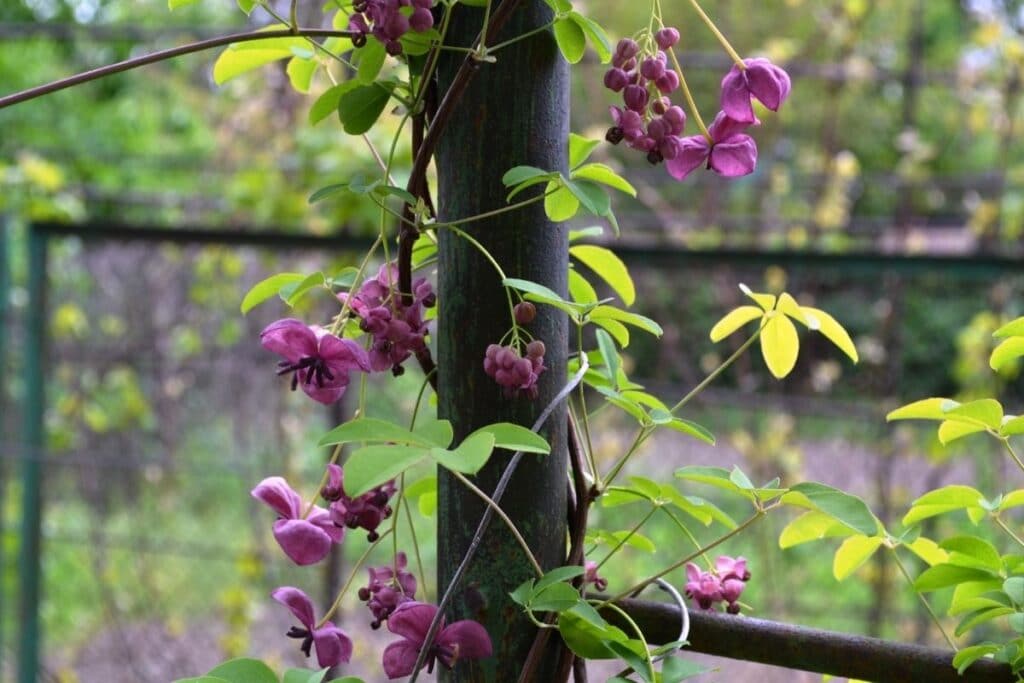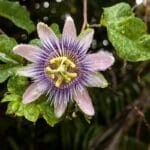Some people are not familiar with the landscaping industry being a science, art, and business. Every plant placed in one’s landscape design has its purpose that is carefully thought out and planned. Proper plant selection is one of the crucial steps in making the landscape work even in the long run.
The Chocolate Vine or Akebia quinata is one of the plants that can serve both its landscape use and adds to the appearance of the place. The plant gives off texture and color for the design with its five-leaved crawling structure with purple flowers and a sweet aroma.
However, when not wanted, it can be a serious weed problem as it grows vastly to the point that chemical control will be needed.
Botanical information
Akebia quinata, from the family Lardixabalaceae, is a woody deciduous plant commonly known as Chocolate Vine but also goes by the names Five-Leaf Akebia, Akebia, Chocolate Vine, and Raisin Vine.
It was originally from the eastern parts of Asia, such as Central China, Japan, and Korea. The vine was imported mainly because of its unique appearance that seems to have a positive effect on aesthetics. In the United States, it is most suitable to grow in zones 4-8.
Chocolate vine is composed of five leaves in a muted blue-green shade connected by a slender stem. The stem will be green in color during the plant’s young age but will eventually turn brown as it grows older. It also develops a useful plant part called tendrils, which are modified stems used mostly for anchorage. Additionally, the plant produces male and female flowers.
The name “Chocolate Vine” was coined due to its flowers, wherein they are chocolate-purple and give off a sweet smell like vanilla and chocolate and they bloom in bundles. As it matures, long violet flat pods around 8-9 cm long are produced with black seeds inside.
How to Grow and Care for Akebia quinata

Just like any other plant, the this purple flowering vine needs basic requirements such as water, sunlight, nutrition, and relative humidity to optimize its growth.
Sunlight Requirement
Due to its crawling and climbing nature, this vine can easily survive on its own everywhere. It does not require much attention and maintenance and grows vastly. As a versatile vine, it can grow in exposure to full sunlight, partial shade, and full shade. However, partial shade is where its spring growth can be optimized, and delicate flowers tend to flourish in this humid and warm spot.
Water Requirement
These rich purplish brown blooms grow best when planted in soil that is moist but has good drainage under partial shade. Besides, it developed a resistance to a wide range of conditions such as drought, frost, and harsh winter weather.
Fertilizer Application
In terms of fertilizer, it does not need much as long as there is enough organic matter. Organic matter can take the form of manure, dead plant parts, and other debris in the garden. Additionally, this plant’s dense foliage contributes to its overall health and appearance.
Soil Requirement
Growing chocolate vine in well-draining, fertile soil with a slightly acidic to neutral pH level, typically between 6.0 and 7.0 is ideal. It prefers loamy or sandy soil enriched with organic matter, such as compost or aged manure, to promote healthy growth.
Ensure the soil retains moisture without becoming waterlogged, as excessive moisture can lead to root rot. Regularly amend the soil with organic matter to maintain fertility and improve drainage.
Propagating Chocolate Vine
In reproducing the Chocolate Vine, the tiny black seeds from the flat pods can be used primarily. It is possible to spread it manually or through natural agents such as wind, water, and birds. Other propagation methods include cuttings of softwood as plant material.
Also, layering is one of the simplest methods to propagate Akebia vine. It can be done by bending down soft stems to the ground level and making a small opening. Applying a rooting hormone, such as Auxin (commonly known as IAA or IBA), to the small opening can hasten the development of roots. Once the stem has been rooted, it is ready to be separated from the mother plant.
In comparison to cuttings, layering is more beneficial since it allows the stem to develop the roots while attached to the mother plant. The food and water supply of the plant is continuous making it less stressful for the plant to grow and focus on rooting.
Landscape Uses
Since this perennial vine has a climbing and twining morphological feature, it is best used as a twining vine or ground cover in the landscape. It can be incorporated in wall-side borders, walls, fences, pergolas, trellises, and arbors to soften the features of the said structures.
Moreover, the versatility and resistance of Akebia make it a good choice for ground cover. It can withstand foot traffic if placed near a pathway, and it spreads easily, which ensures that the ground will be covered fully. Additionally, its dark foliage will help create an attractive and lush appearance, even around tree stumps.
Possible Harm
Despite the benefits of using Chocolate Vine in the landscape, just like any fast-growing crop, it can be harmful when it starts growing in places where it is undesired. Its strong and twining stem and tendrils can make it strong enough to kill a shrub once it attaches to it. As it grows bigger, its glossy dark green leaves can hinder the penetration of sunlight for the underlying vegetation.
Control
For landscape purposes, scheduled pruning is a must to avoid the vine from dominating the whole landscape. It can be pruned until it reaches the ground to rejuvenate especially after flowering.
Similar to some of the fastest growing vines, when it comes to eradicating the chocolate vine, manual weeding is advised and is done by pulling out the plant. However, this method is tedious and labor-intensive as it needs to be done frequently.
On the other hand, the use of herbicides such as glyphosate can kill the vine faster. Remember to read, understand, and follow the instructions on the chemicals, that are to be applied, to avoid any harmful effects.
FAQs
What conditions do chocolate vines like?
Chocolate vines, also known as Akebia, prefer to grow in partial shade to full sun and well-draining soil. They can tolerate various soil types, including sandy or loamy soil, but they perform best in moist, fertile soil.
Can you grow chocolate vine in a container?
Yes, you can grow chocolate vine in a container. Choose a large container with drainage holes to prevent waterlogging, and use a well-draining potting mix. Provide support for the vine to climb, such as a trellis or pergola, and ensure it receives adequate sunlight.
Why is my chocolate vine not blooming?
A chocolate vine may not bloom if it is not receiving enough sunlight, is not mature enough, or if it has been pruned at the wrong time. Additionally, environmental factors like temperature and humidity can affect blooming. Ensure the plant is provided with proper care and growing conditions to encourage flowering.
Does chocolate vine climb?
Yes, chocolate vine is a climbing vine that uses tendrils to cling and climb. It can climb up structures such as trellises, arbors, fences, or walls.
How long does it take for chocolate vines to flower?
Chocolate vines typically flower in early spring or early summer, but the exact timing can vary depending on factors like climate and growing conditions. Generally, it takes a few years for a chocolate vine to mature and produce fragrant flowers.
Is chocolate vine self fertile?
Yes, Chocolate vines are usually self-fertile, meaning they can produce fruit and seeds without the need for cross-pollination with another plant. However, having multiple chocolate vine plants nearby can increase fruit set and yield.
*image by olg44391.yandex.ru/depositphotos






